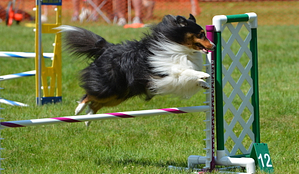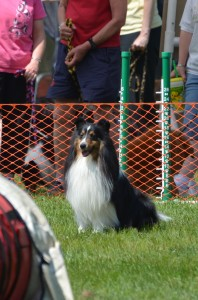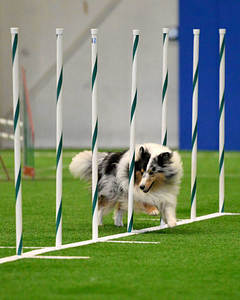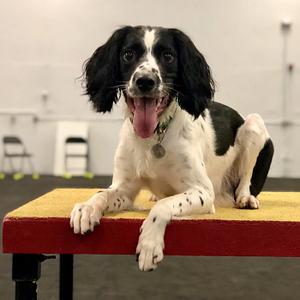
What is a behavior chain?
A behavior chain is an event in which units of behavior occur in sequences and are linked together by learned cues. -Karen Pryor
What does that mean in English? A behavior chain is a performance in which behaviors are strung together by cues the learner understands. Cue-behavior-cue-behavior-cue-behavior-cue-behavior, followed by a consequence at the end of the chain (reinforcement or punishment).
Here’s an agility example:
“Sit.” -> dog sits
“Okay!” -> dog runs
“Jump!” -> dog jumps
“Tunnel!” -> dog runs through the tunnel
“Poles!”->dog weaves 6 poles
“Jump!” -> dog jumps
handler gives the dog a toy and plays with the dog.
Our handling is a cue. Cues are not limited to verbals! Cues are anything the dog perceives that suggest to them, “if you engage in this behavior now, you are likely to earn a reward.” All of the body language we use to navigate the dog around the course “counts” as a cue – our hand signals, shoulders, feet, motions, etc. in addition to our words.
As long as there is no interruption in the chain, like the dog leaving work to go sniff or visit ring crew, the entire sequence is reinforced when the dog receives a reward at the end, like tasty treats or a game of tug.
Cues Act as Clicks
In clicker training, you teach the dog the correct response by “clicking” when he does the desired behavior, then following up that click with a treat, toy, or other reward that the dog desires. “Click and then treat” is a popular mantra.
Here is the second mantra to memorize: cues act as clicks.
You can train your dog to do a new behavior by marking it with a cue to do a different known behavior. If you’re skeptical about this whole “behavior chain” thing, try it.
When I was first learning about behavior chains in Karen Pryor Academy, I trained Strata to rest his chin on my computer chair by cueing him to “poke” (his verbal cue for a nose target to my hand) every time he approached the chair, sniffed the chair, etc. He would come over to touch my hand and earn a click and a treat, and then I would wait for him to interact with the chair again. In five minutes he was resting his chin on the chair.
To be clear: I never clicked the chin rest behavior. In lieu of clicking, I gave him the cue for the hand target, which was then clicked and rewarded.
Agility Behavior Chain Applications

Strata on the start line, meeting my criteria: butt on ground, front feet still, quiet mouth. (Photo by Katie Rogers, Smiling Wolf Photography)
Start Line Stays
Upon learning about behavior chains I immediately understood why my philosophy for start-line stays works so well. I have never “gone back to reward” my dogs for start lines. (This sounds like blasphemy to many trainers, but hear me out.)
What does my dog want most of all when he is on the start line? The equipment! So, I let him have it if he meets my criteria for staying: butt on ground, front feet still, quiet mouth.
I thought this was an application of the Premack Principle (another important concept I will blog about soon!) but in reality, it’s just a good old-fashioned behavior chain. Sit, remain sitting as I lead out, release, take equipment, play tug with me.
A friend of mine recently asked “Doesn’t that just reward the release?” and the answer is “Nope!” I “clicked” my dog for staying properly with his release cue. The whole behavior chain is rewarded.
Stopped Contacts
A lack of understanding of behavior chains is how trainers destroy their stopped contacts in the ring.
Here’s the scenario: the dog gets excited during a run and strides right through the dogwalk contact zone instead of stopping in two-on two-off position. The handler wants to continue running (continuing the run is positively reinforcing to the human!) and cues the dog to take the next obstacle, thereby rewarding the new performance of running through the contact, which doesn’t actually meet the handler’s criteria for dogwalk contact performance.
The dog has just learned that there is wiggle room in dogwalk criteria. Depending on how weak the correct contact behavior is, he’ll likely start offering some other “creative” dogwalk performances, like coming off the side of the contact or leaping over it.
Now that “Fix & Go” is allowed in all major agility organizations, you have the opportunity to address this in the ring. If my dog does not meet my criteria on a stopped contact, my goal is to pause (interrupting the behavior chain), then re-attempt the obstacle.
Weave Poles

Why are weave pole problems less common than contact problems? Easy! Because we’re allowed to go back and fix our weave poles in competition. In fact, this is encouraged in the lower levels in many venues. AKC gives us 3 attempts at the weave poles in all classes, and they are “not judged” in Novice – you just have to get through them. 3 attempts is almost always sufficient to get a dog through the poles.
Also, due to the repetitive nature of weaving, once the dog figures out a rhythm it is less common for them to pop out. It’s a less complicated obstacle for the dog to perform correctly, in contrast to the dogwalk (run like hell, stay balanced, come to a complete stop, wait patiently, now run again).
If my dog pops out and I can’t fix it in the 3 attempts* that AKC gives me, I will leave the course. If I let my dog continue running, I have rewarded that weave pole performance. It is no different than if I tossed a toy or treat to my dog for popping out at pole 10 or missing the correct entry.
*=you now have a 4th attempt. If you have not yet used your “Fix & Go” in AKC, you can attempt the weave poles a 4th time and it will count as a F&G.
Table

Some dogs are actually experiencing an improvement in their table behavior, in that they are assuming the down position faster than they were previously. Why? Because as soon as they got on the table, the judge’s countdown started. By the time the dog assumes the “down” position, the judge’s count is down to “2, and 1, and go!” The handler quickly releases the dog.
From the dog’s perspective, getting into a “down” immediately earned him the release cue to take the next obstacle! The feedback was faster and the dog made the connection that the sooner he “downs” the sooner he gets to “go” again. Therefore, these dogs start lying down faster and faster on the table. Great!
On the other side of the coin, some dogs have learned that the “down” is now optional, which did not help them in USDAA! (Editor’s note: at the time this article was published, USDAA still required a down on the table. It is now positionless.) In this scenario, the dog gets on the table in AKC and the countdown starts. The handler begins pleading with the dog to lie down. Maybe the dog sits. Maybe he does half a down. The judge finishes the countdown. The dog still isn’t in a down position.
Now what? According to the AKC agility rep I spoke to, if the dog and handler are currently clean the handler may take as much time as they would like, up to the Standard Course Time, to get the dog to lie down. If the team has already faulted they must go on when the judge instructs them to do so, or they will be eliminated for “training in the ring.”
From a behavior chain standpoint, if the dog does not lie down and the handler goes on, the dog has been rewarded for non-compliance with the “down” cue. If you want to keep the “down” behavior strong, you need to insist on it the same way you do with contacts and start-lines. Take the time you need to get the dog to lie down or leave the course if it’s just not happening today. (Or, acknowledge that you’re taking a risk, go on, and spend the next couple weeks brushing up on your dog’s table performance!)
In Conclusion
I hope this post has clarified behavior chains and how they impact our dogs’ agility performance. If you’d like to learn more about behavior chains, here are some resources.
- Making the Connection: Behavior Chains – Karen Pryor, clickertraining.com
- Cues as Reinforcers in Agility – Tia Guest, clickertraining.com
- Tugging as Part of a Behavior Chain – Bad Dog Agility
This blog post was originally published in 2014, then lost for many years due to a website crash. Thanks to The Wayback Machine, we were able to save it! It’s been lightly edited for clarity and re-published.
